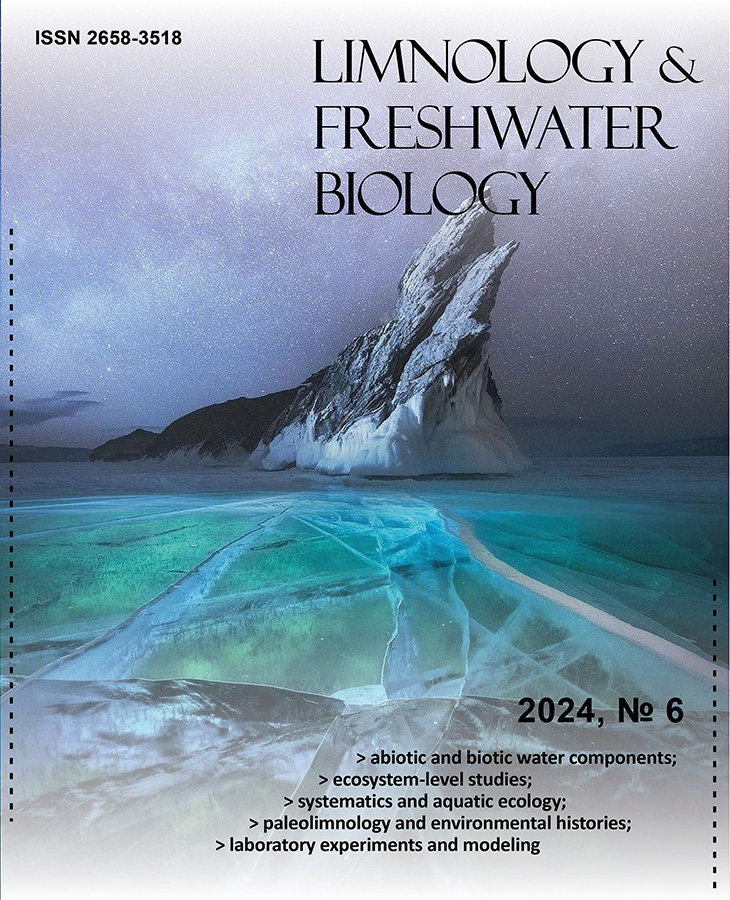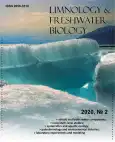Morphological differentiation of the otoliths of graylings from the Barguzin River and Lake Baikal
- Authors: Anoshko P.N.1, Dzyuba E.V.1, Smolin I.N.1, Telpukhovsky A.N.2, Matveev A.N.3
-
Affiliations:
- Limnological Institute of the Siberian Branch of the Russian Academy of Sciences
- Angaro-Baikal Territorial Division of The Federal Agency for Fishery
- Irkutsk State University
- Issue: No 2 (2020)
- Pages: 382-386
- Section: Articles
- URL: https://journal-vniispk.ru/2658-3518/article/view/283756
- DOI: https://doi.org/10.31951/2658-3518-2020-A-2-382
- ID: 283756
Cite item
Full Text
Abstract
A comparative analysis of distinctive morphological features of sagittae in the Thymallus species from Lake Baikal and the Barguzin River has been done. The otolith shape was described using values of radii and the Fourier descriptors. It is demonstrated that the otoliths of Thymallus species have a similar structure. The otolith outline analysis allowed to differentiate the samplings according to the morphotypes that characterize them. No significant differences in length, width, perimeter and area of the otoliths in the Thymallus species have been identified. However, some differences in the shape of otoliths were described in T. baicalolenensis; they had a less developed pararostrum and more salient ventral edge than the otoliths of T. baicalensis from the lakes Balan-Tamur and Baikal. The otolith shape analysis can be widely applied for basic research of microevolutionary processes, delimitation of natural populations and preservation of genetic diversity as well as for defining the structure of the commercial stock.
Keywords
About the authors
P. N. Anoshko
Limnological Institute of the Siberian Branch of the Russian Academy of Sciences
Email: ursus.88@mail.ru
Russian Federation, 3, Ulan-Batorskaya St., Irkutsk, 664033
E. V. Dzyuba
Limnological Institute of the Siberian Branch of the Russian Academy of Sciences
Email: ursus.88@mail.ru
Russian Federation, 3, Ulan-Batorskaya St., Irkutsk, 664033
I. N. Smolin
Limnological Institute of the Siberian Branch of the Russian Academy of Sciences
Author for correspondence.
Email: ursus.88@mail.ru
Russian Federation, 3, Ulan-Batorskaya St., Irkutsk, 664033
A. N. Telpukhovsky
Angaro-Baikal Territorial Division of The Federal Agency for Fishery
Email: ursus.88@mail.ru
Russian Federation, 18, Smolin St., Ulan-Ude, 670000
A. N. Matveev
Irkutsk State University
Email: ursus.88@mail.ru
Russian Federation, 5, Sukhe-Bator St., Irkutsk, 664011
References
- Abuanza P., Murta A.G., Campbell N. et al. 2008. Stock identity of horse mackerel (Trachurus trachurus) in the Northeast Atlantic and Mediterranean Sea: integrating the results from different stock identification approaches. Fisheries Research 89: 196-209. doi: 10.1016/j.fishres.2007.09.022
- Afanasyev P.K., Orlov A.M., Rolsky A.Yu. 2017. Otolith shape analysis as a tool for species identification and studying the population structure of different fish species. Russian Journal of Zoology 96: 192-200. doi: 10.1134/S1062359017080027
- Anoshko P.N., Telpukhovskiy A.N., Fedorova L.I. et al. 2007. Aberrant otoliths of Baikal grayling. Acta Biomedica Scientifica 2: 10–13. (in Russian)
- Ballagh A.C., Begg G.A., Mapleston A. et al. 2006. Growth trends of Queensland east coast Spanish mackerel (Scomberomorus commerson) from otolith back-calculations. Marine and Freshwater Research 57: 383-393. doi: 10.1071/MF05173
- Begg G.A., Overholtz W.J., Munroe N.J. 2001. The use of internal otolith morphometrics for identification of haddock stocks on Georges Bank. Fishery Bulletin 99: 1-14.
- Bergenius M.A.J., Begg G.A., Mapstone B.D. 2006. The use of otolith morphology to indicate the stock structure of common coral trout (Plectropomus leopardus) on the Great Barrier Reef, Australia. Fishery Bulletin 104: 498-511.
- Bolles K.L., Begg G.A. 2000. Distinction between silver hake (Merluccius bilinearis) stocks in U.S. waters of the northwest Atlantic based on whole otolith morphometrics. Fishery Bulletin 98: 451-462.
- Cadrin S.X., Friedland K.D. 2005. Morphometric outlines. In: Cadrin S.X., Friedland K.D., Waldman J.R. (Eds.), Stock identification methods: applications in fisheries science. Amsterdam, pp. 173-183.
- Campana S.E., Casselman J.L. 1993. Stock discrimination using otolith shape analysis. Canadian Journal of Fisheries and Aquatic Sciences 50: 1062-1083. doi: 10.1139/f93-123
- Campana S.E., Gagne ́ J.A., McLaren J.W. 1995. Elemental fingerprinting of fish otoliths using ID-ICPMS. Marine Ecology Progress Series 122: 115-120. doi: 10.3354/meps122115
- Castonguay M., Simard P., Gagnon P. 1991. Usefulness of Fourier analysis of otolith shape for Atlantic mackerel (Scomber scombrus) stock discrimination. Canadian Journal of Fisheries and Aquatic Sciences 48: 269-302. doi: 10.1139/f91-041
- DeVriesa D.A., Grimes C.B., Prager M.H. 2002. Using otolith shape analysis to distinguish eastern Gulf of Mexico and Atlantic Ocean stocks of king mackerel. Fisheries Research 57: 51-62. doi: 10.1016/S0165-7836(01)00332-0
- Ding L., Tao J., Ding C. et al. 2019. Hydrogeomorphic factors drive differences in otolith morphology in fish from the Nu‐Salween River. Ecology of Freshwater Fish 28: 132-140. doi: 10.1111/eff.12437
- Gauldie R.W. 1993. Polymorphic crystalline structure of fish otoliths. Journal of Morphology 218: 1-28. doi: 10.1002/jmor.1052180102
- Furlani D., Gales R., Pemberton D. 2007. Otoliths of common Australian temperate fish: a photographic guide. Hobart: CSIRO Publishing.
- Johnson A.G. 1996. Use of otolith morphology for separation of king mackrel (Scomberomorus cavalla) and Spanish mackerel (Scomberomorus maculates). Gulf of Mexico Science 1: 1-6. doi: 10.18785/goms.1401.01
- Jonsdottir I.G., Campana S.E., Marteinsdottir G. 2006. Otolith shape and temporal stability of spawning groups of Icelandic cod (Gadus morhua L.). ICES Journal of Marine Science 63: 1501-1512. doi: 10.1016/j.icesjms.2006.05.006
- Khrustaleva А.М., Pavlov D.А. 2000. Features of otolith morphology in the young of several fish species from the White Sea. Journal of Ichthyology 40: 655-667.
- Libungan L.A., Slotte A., Otis E.O. et al. 2016. Otolith variation in Pacific herring (Clupea pallasii) reflects mitogenomic variation rather than the subspecies classification. Polar Biology 39: 1571-1579. doi: 10.1007/s00300-015-1882-x
- Lychakov D.V., Rebane Y.T. 1992. Effect of otolith shape on directional sound perception in fish. Journal of Evolutionary Biochemistry and Physiology 28: 531-536.
- Lychakov D.V., Rebane Y.T. 2000. Otolith regularities. Hearing Research 143: 83-102. doi: 10.1016/s0378-5955(00)00026-5
- Matveev A.N., Samusyonok V.P., Telpukhovsky A.N. et al. 2005. A new subspecies of the Siberian grayling Thymallus arcticus baicalolenensis ssp. nova (Salmoniformes, Thymallidae). Vestnik Buryatskogo Gosudarstvennogo Universiteta Seriya 2. Biologiya [Bulletin of the Buryat State University Series 2. Biology] 7: 69-82. (in Russian)
- Pavlov D.А. 2016. Differentiation of three species of the genus Upeneus (Mullidae) based on otolith shape analysis. Journal of Ichthyology 56: 37-51. doi: 10.1134/S0032945216010094
- Popper A.N., Ramcharitar J., Campana S.E. 2005. Why otolith? Instings from inner ear physiology and biology. Marine and Freshwater Research 56: 497-504. doi: 10.1071/MF04267
- Prosekin K.A., Prosekina А.А. 2009. To the question on strategy with-existence bajkalolensky and black bajkalsky charius in the conditions of symparion (reserve Dzherginsky). Samarskaya Luka: Problemy Regional’noy i Global’noy Ekologii [Samarskaya Luka: Problems of Regional and Global Ecology 18: 161-164. (in Russian)
- Prosekin K.A. 2007. Ecological and biological features of graylings from waterbodies and streams of the upper Barguzin River (Pribaykalye). Cand. Sc. Dissertation, Institute of General and Experimental Biology of the Siberian Branch of the RAS, Ulan-Ude, Russia. (in Russian)
- Rooker J.R., Secor D.H., DeMetrio G. et al. 2008. Evidence of trans-Atlantic movement and natal homing of bluefin tuna from stable isotopes in otoliths. Marine Ecology Progress Series 368: 231-239. doi: 10.3354/meps07602
- Skalkin V.A. 1963. Otoliths of some fishes from Far East seas. Proceedings of Pacific Research Institute for Marine Fisheries and Oceanography. 59: 159-200.
- Skazkina E.P. 1965. Differences in the otoliths between the Azov Sea and the Black Sea anchovy (Engraulis encrasicholus maeoticus Pusanov, Engraulis encrasicholus ponticus Aleks.). Journal of Ichthyology 5: 600-605.
- Svetocheva O.N., Stasekova N.I., Gosheva T.D. 2002. Otolith morphology of some fishes of the White Sea. Journal of Ichthyology 42: 360-367.
- Tyagun M.L., Anoshko P.N., Voronov M.G. 2013. Otolith shape analysis to discriminate among morpho-ecological groups of Baikal omul (Coregonus migratorius Georgi). Advances in Limnology 64: 109-118. doi: 10.1127/1612-166X/2013/0064-0018
- Yukhov V.L. 1971. Structure of the otoliths of the Antarctic and the Patagonian toothfish Dissostichus mawsoni Norm. and D. elegenoides Smitt of the Southern Ocean. Journal of Ichthyology 11: 587-594.
- Zischke M.T., Litherland L., Tilyard B.R. et al. 2016. Otolith morphology of four mackerel species (Scomberomorus spp.) in Australia: species differentiation and prediction for fisheries monitoring and assessment. Fisheries Research 176: 39-47. doi: 10.1016/j.fishres.2015.12.003
Supplementary files










